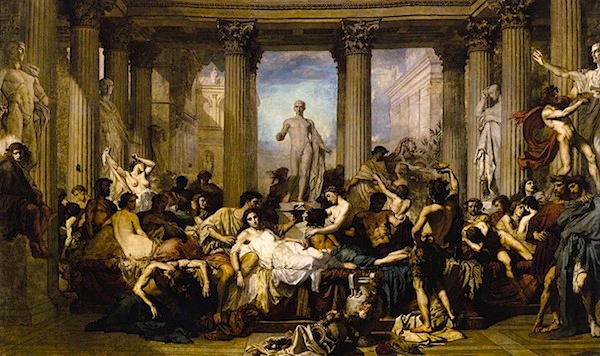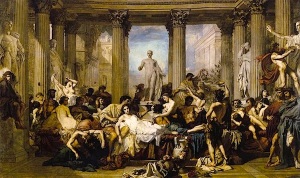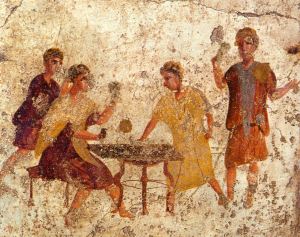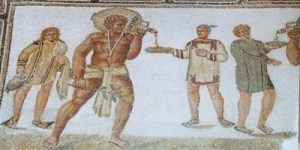Today we celebrate Christmas as a Christian festival, unfortunately commercialised by the West in more recent years. However, the falling of Christmas has fallen conveniently; in the same month as one of the highlights of the Roman calendar, Saturnalia.
Saturnalia was the 17th day of the month December in the Julian calendar, and celebrated the god Saturn. Later the festivities continued on up to the 23rd December (or Christmas Eve Eve to some of us!)
Thomas Couture captures Roman Saturnalia festivites that may look a familiar scene to modern readers!
“The Best of Days” (Catallus)
Saturnalia was a festival that many looked forward to, particularly slaves as it was the one day when they did not have to work and when they were treated to a banquet of the sort usually enjoyed by their masters. The day would begin with a sacrifice at the Temple of Saturn (in the Roman Forum) and then would continue with a large, public banquet at the temple, which we know thanks to Livy. After eating, individuals would give gifts to their loved ones and then the party would begin. The festival had a carnival atmosphere and overturned the norms of Roman virtues – gambling was permitted, among other normally taboo activities (including the virtual equality of slaves for the day, as previously mentioned). As History Extra describe it, “It was a topsy-turvy holiday of feasting, drinking, singing in the street naked, clapping hands, gambling in public and making noise.”
Gambling (dice games) portrayed in a Pompeiian image in the Osteria della Via di Mercurio
Carrying on the ‘topsy-turvy’ festival, the aristocracy would ‘put together’ any outfit they fancied, wearing colours and material outside of their usual conservative outfits. This was called the ‘synthesis’. Also, people would wear the pilleum, the hat worn by slaves who had been freed, to symbolise being free for the day. Thanks to Macrobius, we also know that the rowdy festival-goers would greet one another as we might on Christmas day, shouting “Io Saturnalia!” to one another.
Slaves celebrating the Saturnalia with a drink or two
Even more along the same lines as us, Aulus Gellius confessed to playing trivia games with friends as a student, and the public would play other silly games, such as bobbing for corks in icy water (much like apple bobbing at Halloween!) Chariot racing was also a large part of the day, with up to 36 races per day carried out by the late fourth century AD.
Not the highlight of everybody’s calendar
Seneca was known to have a moan about the mob getting out of control “in pleasantries”and Pliny the Younger revealed in a letter that he was not such a party animal, holing himself up while the rest of the household partied on the festival day.
As can be expected, early Christians objected to the festivities of the day too. Even though the Church fathers could not before decide on the official date of the birth of Christ, they at last settled on the date 25th of December in the late fourth century (yes, that late!) Now, I don’t intend to be controversial here, but it is to me not a coincidence that the Church Fathers decided on a time of year that was the time when the Roman world came together not only to celebrate a Pagan god but also to celebrate in a way that didn’t quite sit well with the value of the Church. The Church even complained when the festivities of the Saturnalia continued into the eighth century with the old Pagan values.




Reblogged this on shockysblog.
LikeLike